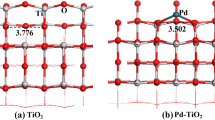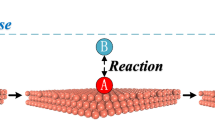Abstract
To ensure the operating stability of SF6-insulated equipment, an Ni-MoS2 monolayer has been used as an adsorbent to remove the characteristic decomposition products of SF6, viz. SOF2 and SO2F2 gases, from SF6-insulated equipment. All of the calculations are carried out in the density functional theory (DFT) framework. Several adsorption configurations are built and optimized to determine the most stable adsorption structure. In addition, the adsorption geometry, adsorption energy, density of states (DOS), charge transfer, transition states, and electron density difference are calculated to analyze the adsorption properties. The results show that the Ni-MoS2 monolayer exhibits excellent adsorption properties towards both target gases. SOF2 adsorbs on the Ni-MoS2 monolayer by nondissociative chemisorption, while SO2F2 adsorption occurs via dissociative chemisorption. Due to the strong chemical activity of Ni, it significantly increases the electrical conductivity and enhances the adsorption properties of MoS2. The Ni-MoS2 monolayer shows excellent sensitivity to SOF2 and SO2F2, reflected in decreases of the electrical conductivity after adsorption of SOF2 and SO2F2. The Ni-MoS2 monolayer could thus be a promising material for removal of these characteristic SF6 decomposition products under partial discharge conditions. The results of these calculations provide a new approach to ensure the operational stability of SF6-insulated gas-insulated switchgear (GIS) equipment.








Similar content being viewed by others
References
M. Maiss and C.A.M. Brenninkmeijer, Environ. Sci. Technol. 32, 3077 (2015).
I.A. Metwally, Electr. Power Syst. Res. 69, 25 (2004).
F. Zeng, J. Tang, Y. Xie, Q. Zhou, and C. Zhang, J. Electr. Eng. Technol. 10, 1787 (2015).
M. Iio, M. Goto, H. Toyoda, and H. Sugai, Contrib. Plasma Phys. 35, 405 (1995).
X. Zhang, Y. Gui, Y. Zhang, Y. Qiu, and L. Chen, IEEE Trans Dielectr. Electr. Insul. 23, 2633 (2016).
C. Beyer, H. Jenett, and D. Klockow, IEEE Trans Dielectr. Electr. Insul. 7, 234 (2000).
B. Liu, J.G. Zhang, and G. Shen, Nano Today 11, 82 (2016).
J.C. Spear, B.W. Ewers, and J.D. Batteas, Nano Today 10, 301 (2015).
C. Zhu, L. Han, P. Hu, and S. Dong, Nanoscale. 4, 1641 (2012).
N.E. Shi, C.Y. Song, J. Zhang, C. Yuan, and W. Huang, Acta Phys (Sin: Chim, 2011).
B. Cho, J. Yoon, S.K. Lim, A.R. Kim, D.H. Kim, S.G. Park, J.D. Kwon, Y.J. Lee, K.H. Lee, B.H. Lee, H.C. Ko, M.G. Hahm, and A.C.S. Appl, Mater. Interfaces 7, 16775 (2015).
Q. Yue, Z. Shao, S. Chang, and J. Li, Nanoscale Res. Lett. 8, 425 (2013).
S.Y. Cho, S.J. Kim, Y. Lee, J.S. Kim, W.B. Jung, H.W. Yoo, J. Kim, and H.T. Jung, ACS Nano 9, 9314 (2015).
S.L. Zhang, H. Yue, X. Liang, and W.C. Yang, J. Nanosci. Nanotechnol. 15, 8004 (2015).
S.R. Shakil, N. Tarannum, and M.K. Rhaman, J Nano Electron. Phys. 9, 06003 (2017).
J. Zhu, H. Zhang, Y. Tong, L. Zhao, Y. Zhang, Y. Qiu, and X. Lin, Appl. Surf. Sci. 419, 522 (2017).
A. Sharma, M.S. Khan, M. Husain, and A. Srivastava, IEEE Sens. J. 18, 2853 (2018).
P. Hohenberg and W. Kohn, Resonance 22, 809 (2017).
B. Delley, Comput. Mater. Sci. 17, 122 (2000).
X. Fu, B. Warot-Fonrose, R. Arras, D. Demaille, M. Eddrief, V. Etgens, and V. Serin, Appl. Phys. Lett. 125, 89 (2015).
S.N. Maximoff, M. Ernzerhof, and G.E. Scuseria, J. Chem. Phys. 120, 2105 (2004).
S. Grimme, J. Comput. Chem. 27, 1787 (2006).
Y. Inada and H. Orita, J. Comput. Chem. 29, 225 (2008).
B. Delley, J. Chem. Phys. 92, 508 (1990).
A.P. Rendell, Chem. Phys. Lett. 229, 204 (1994).
D. Naveh, and A. Ramasubramaniam, Phys. Rev. B. 87, 195201 (2014).
D. Ma, W. Ju, T. Li, X. Zhang, C. He, B. Ma, Z. Lu, and Z. Yang, Appl. Surf. Sci. 383, 98 (2016).
R.S. Mulliken, J. Chem. Phys. 23, 1841 (1955).
R.P.A. Bettens and A.M. Lee, Chem. Phys. Lett. 449, 341 (2007).
S.R. Broderick and K. Rajan, EPL 95, 57005 (2011).
B.T. Teng, Y. Zhao, F.M. Wu, X.D. Wen, Q.P. Chen, and W.X. Huang, Surf. Sci. 606, 1227 (2012).
Acknowledgements
This research is funded by the Chongqing Research Program of Basic Research and Frontier Technology (No. cstc2018jcyjAX0068).
Author information
Authors and Affiliations
Corresponding author
Additional information
Publisher's Note
Springer Nature remains neutral with regard to jurisdictional claims in published maps and institutional affiliations.
Electronic Supplementary Material
Below is the link to the electronic supplementary material.
Rights and permissions
About this article
Cite this article
Gui, Y., Sun, H., Wei, H. et al. Effect of Nickel Doping on Adsorption of SF6 Decomposition Products over MoS2 Surface. JOM 71, 3971–3979 (2019). https://doi.org/10.1007/s11837-019-03586-6
Received:
Accepted:
Published:
Issue Date:
DOI: https://doi.org/10.1007/s11837-019-03586-6




